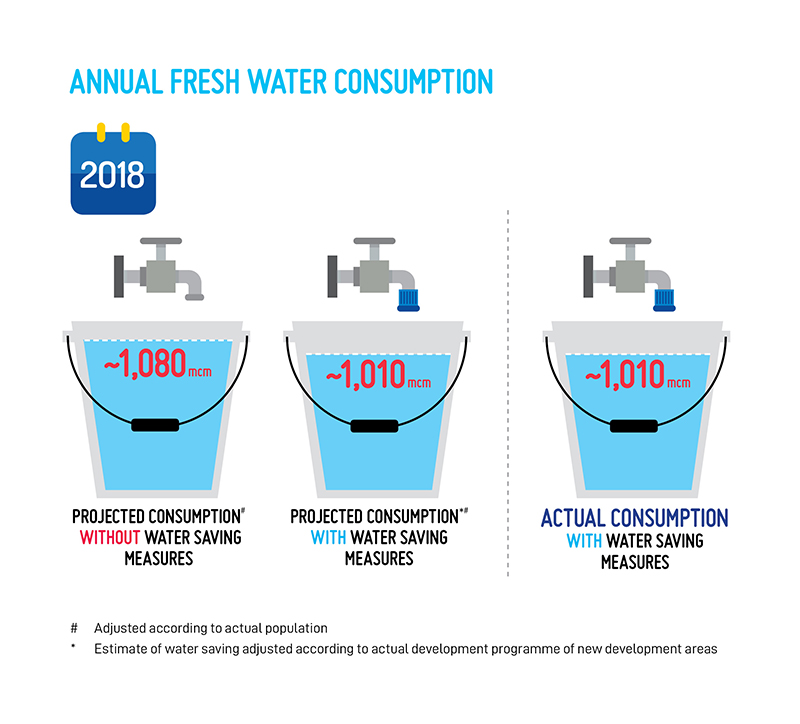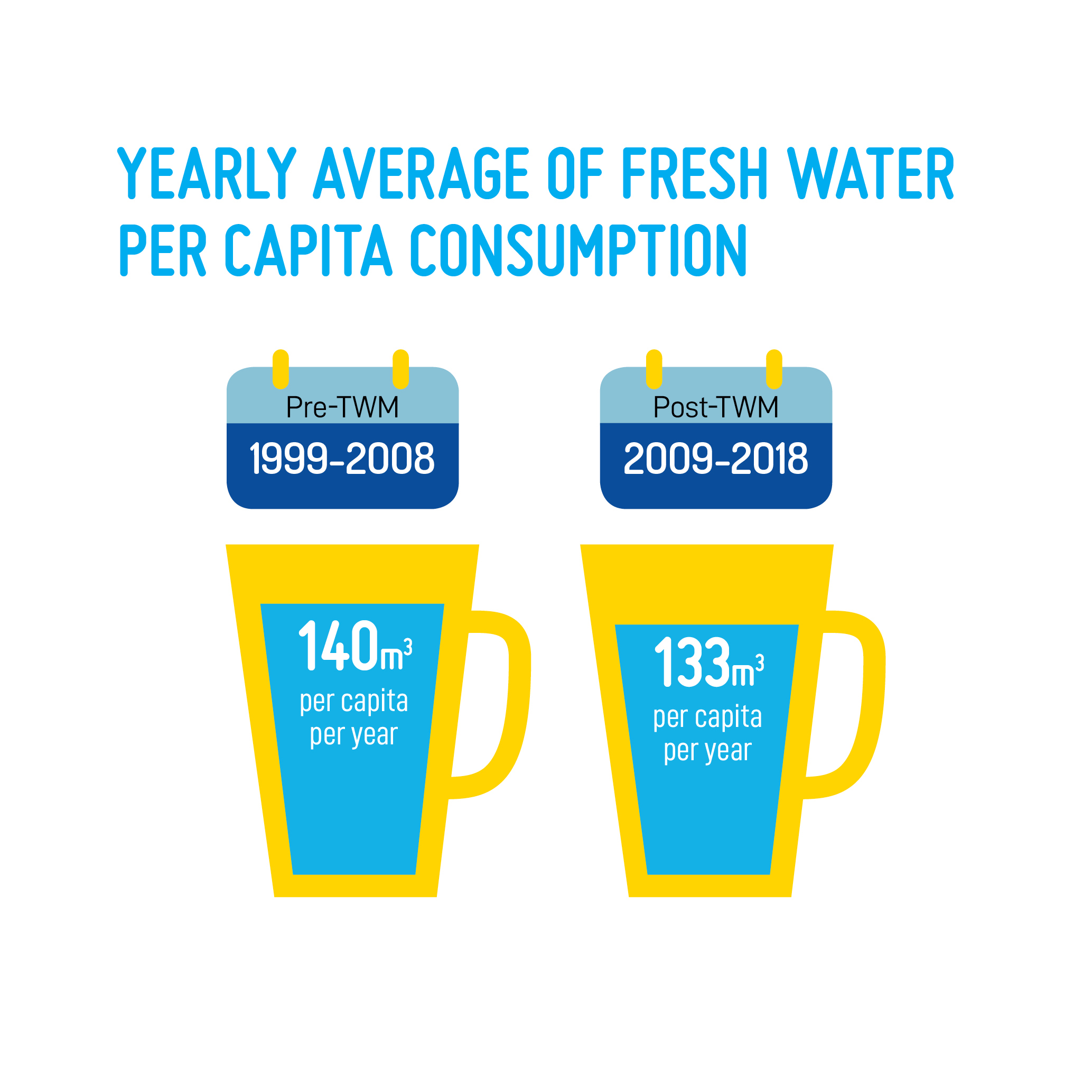Jump to the beginning of content
TWM Review - Introduction
In 2008, we promulgated the Strategy which is an integrated and multi-sectoral approach to achieve sustainability in water resources management. The Strategy focused on containing growth of water demand through conservation whilst strengthening water supply management of Hong Kong through developing new water resources. After its implementation for some years, we engaged consultants to carry out a review on the Strategy in order to:
- ascertain the effectiveness of the Strategy;
- extend the water demand and supply forecast up to 2040;
- formulate, evaluate and recommend the strategic options for meeting the forecasted water demand and supply; and
- update the Strategy.
Completed / On-going Major Initiatives
The Review confirmed the achievement of a number of major initiatives of both water demand and water supply management under the Strategy, including enhancing public education on water conservation, promoting the use of water-saving devices, enhancing water leakage control, extending the use of seawater for toilet flushing, strengthening the protection of water resources and actively exploiting new water resources.
Water Demand Management
- With our sustained publicity and public education programmes, people are now more aware of the importance of water conservation as revealed by the public opinion survey in 2015/16.
- A voluntary Water Efficiency Labelling Scheme (WELS) was successfully launched in phases since 2009. WELS currently covers six major plumbing fixtures and devices including showers for bathing, water taps, washing machines, urinal equipment, flow controllers and water closets1. We have also subsequently required the use of products of certain water efficiency grade(s) in new plumbing installations since 1 February 2017 with one year grace period for prescribed types of plumbing fixtures and devices under WELS namely showers for bathing, water taps and urinal equipment.
- The Replacement and Rehabilitation (R&R) of Water Mains Programme was substantially completed by 2015. About 3,000 kilometres of aged water mains have been replaced and rehabilitated. It has resulted in great reduction in the number of water mains bursts from the peak of about 2,500 in 2000 to around 100 in 2018 and the leakage rate in government water mains from about 25% in 2000 to about 15% in 2018.
- With the improvement of the water supply network achieved by R&R and riding on the technological advancement of sensors, telemetry, network management software and data analysis in recent years, we are implementing Water Intelligent Network (WIN)2 for monitoring the water loss of the fresh water distribution network for follow up action. The WIN strategy was formulated in 2014 and the associated works for its progressive establishment are in progress.
- We have extended the coverage of the seawater supply network for flushing from below 80% to 85% of the population for further reduction of fresh water demand.
Water Supply Management
- We have been developing seawater desalination. We have completed a feasibility study of desalination in Hong Kong and are implementing the first stage of desalination plant in Tseung Kwan O for anticipated completion in 2023.
- We have been actively pursuing water reclamation as an alternative water source. We are implementing the infrastructure in north-eastern part of New Territories including Sheung Shui and Fanling, and preparing the legislation for supply of reclaimed water with a view to starting supply of reclaimed water in phases from early 2024 to those areas where fresh water is still being used for flushing.
- We are going to implement a district-based grey water recycling system at the Anderson Road Quarry development site to collect grey water in the development and treat the grey water for supply to the development for flushing and other non-potable uses. The construction of the grey water treatment plant commenced in 2020 for commissioning to match with the population intake of the development.
- We have been providing ample protection of our water resources including stringent control of developments in the water gathering grounds and proper maintenance of catchwaters in order to safeguard the quality and quantity of local water resources.
- The Drainage Services Department (DSD) is implementing the Inter-reservoirs transfer scheme which serves dual purposes of reducing flood risk in Lai Chi Kok area and increasing local yield. The project is anticipated to be completed by 2022.
Promising Performance in Containing Growth of Water Consumption
The effectiveness of the Strategy can be broadly reflected by two key performance indicators (KPI): (1) the total fresh water consumption and (2) the change of average fresh water per capita consumption (pcc). After implementation of the Strategy, the total fresh water consumption in Hong Kong has been successfully contained at the level of around 1,000 million cubic metres (mcm) over the past ten years notwithstanding with a continuous growth of population at a rate of 0.7% per annum which is on par with the anticipated consumption after the implementation of the water demand management measures projected under the Strategy. As regards the fresh water pcc3, the 10-year average has dropped from 140 to 133 m3 per capita per year after implementation of the Strategy. The above KPI demonstrated the overall effectiveness of the Strategy.
Domestic Fresh Water Consumption
Zooming into the level at domestic household, we observed a mild rising trend of domestic fresh water pcc in recent years which rebounds from the lowest 129 litres in 2010/11 to 135 litres in 2017/18. The increase in domestic fresh water pcc could be attributed to various possible factors including the decreasing trend4 of average domestic household size5, raising awareness of public health and hygiene, as well as upgrading quality of living in Hong Kong6 etc. Nevertheless, with the adoption of seawater for flushing which has effectively reduced fresh water consumption in households, the domestic fresh water pcc in Hong Kong is in fact lower than some other international cities of advanced economies7.
Notes:-
- We conduct periodic review of the Scheme Documents for these plumbing fixtures and devices.
- Under WIN, the fresh water distribution network will be divided into about 2 400 discrete District Metering Areas (DMAs) of manageable size with monitoring and sensing equipment installed in each DMA for continuous monitoring of its water loss.
- The Strategy has been implemented for about 10 years. As the pcc of each year would fluctuate, the 10-year average pcc before and after implementation of the Strategy are compared to evaluate its effectiveness.
- Average domestic household size of 3 in 2008 decreased to 2.8 in 2018
- Pcc in certain daily living activities, e.g. home cleaning and cooking, can be reduced for a larger household size due to more efficient use of water compared to same number of people living in multiple households (i.e. smaller household size).
- Upgrading quality of living in Hong Kong increases pcc due to greater enjoyment in showers (longer time and larger frequency), home and car cleanliness, etc.
- According to a study carried out by the University of Hong Kong in 2015, the domestic fresh water pcc (litre per capita per day) in 2011 was 128.9 for Hong Kong, while the domestic pcc of other cities were: 214.5 for Beijing; 222 for Taipei; 174 for Shenzhen; 153 for Singapore; and 218.9 for Sydney. These cities use fresh water for flushing.
TWM Review - Introduction

